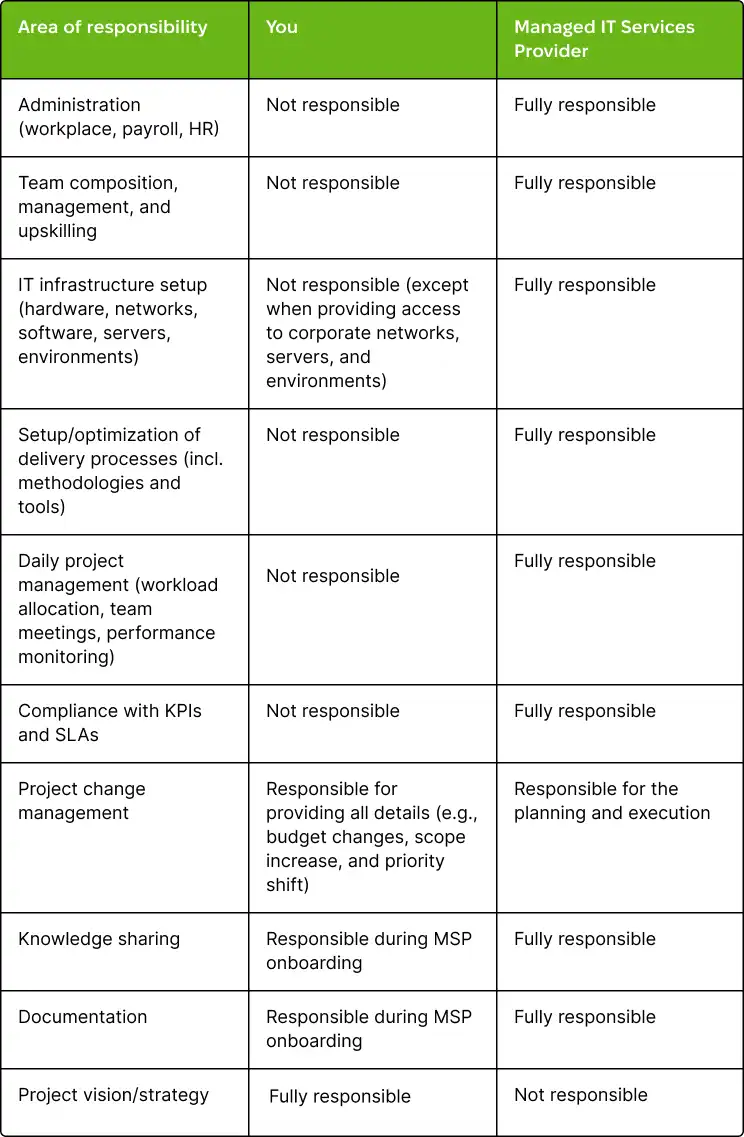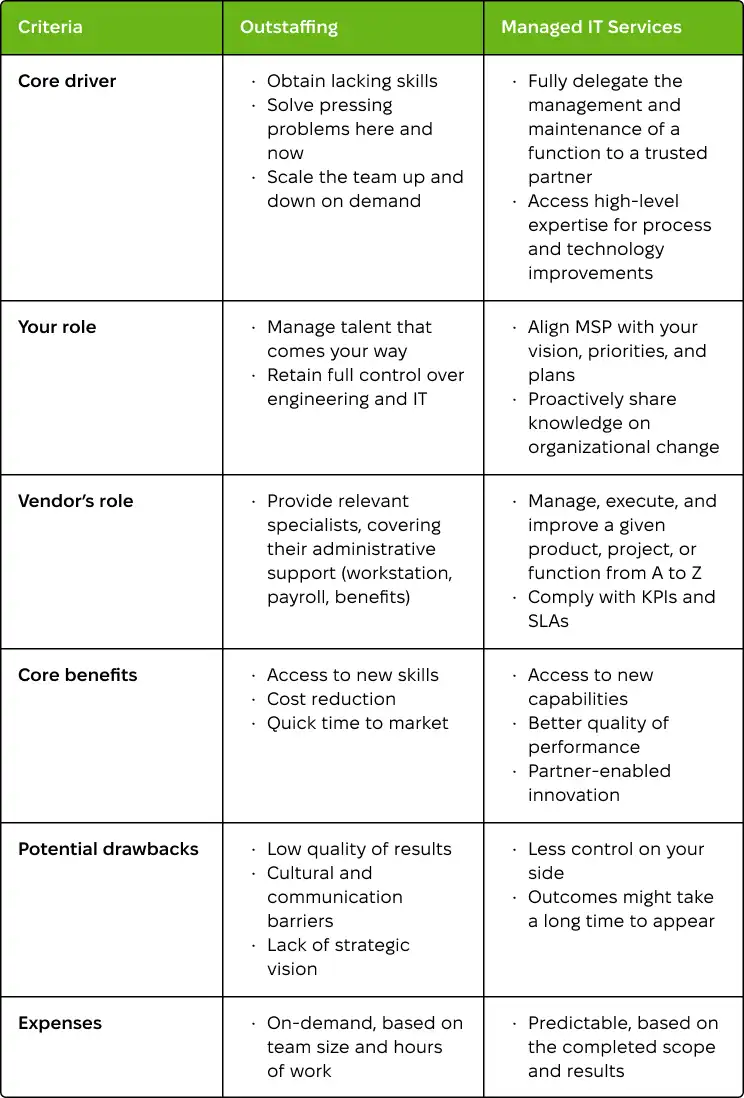More companies are switching to managed services, seeking outcome-based delivery, service quality, and long-term technology partnerships. At least 88% of managed IT services adopters say this model meets or exceeds their expectations. Read our article to learn how managed IT differs from traditional outstaffing in terms of responsibilities, benefits, and risks so you can choose the right model for your goals.
Fresh off your last outstaffing journey, you're left with mixed feelings. Cost and time savings were palpable, yet you remain stuck with poorly written code, technical debt, and inadequate documentation.
Some companies solve this conundrum by bringing back in-house capabilities. However, insourcing can incur more upfront costs and take more time due to skill shortages. Others see the remedy in more outcome-based IT delivery models, such as managed IT services.
Managed IT services
compete with legacy outsourcing models, attracting companies that seek spend optimization, high-quality performance, and tangible value. According to PwC,
more than ⅔ of top-performing organizations
opt for managed services for strategic initiatives or to close critical capability gaps.
Find out if you should adopt managed IT services by learning the upsides and downsides of this model. Consider the differences between managed IT services vs. outstaffing and what each option has to offer.
What Are Managed IT Services?
Managed IT service (or managed IT outsourcing) is an engagement model where a third-party vendor assumes full or partial responsibility for your tech-related tasks, processes, or functional areas.
Managed IT services are the next best thing on the outsourcing scene. They deliver a greater return on investment and longer-term value than capacity-based models. Rather than sending extra hands for quick fixes, a managed IT services provider (MSP) delivers outcome-based results, aligns with your operating model, and combines their services to achieve your strategic goals.
There is a tendency to limit managed IT services to system monitoring, maintenance, and tech support. They, however, can involve end-to-end management of other critical projects:
- Application modernization
- Enterprise solution architecting
- Platform development
- Engineering operations
- Artificial intelligence (AI)
- IT infrastructure optimization
- Data management
Managed IT outsourcing isn't about delegating work from your overwhelming backlog. It's about establishing a partnership – one where a managed services provider refines your IT initiatives, optimizes your system development lifecycle (SDLC), and proactively shares their knowledge. Because they are accountable for the results, MSPs aren't afraid to challenge your ideas if the latter are unfeasible or go against technology best practices.
Managed services entail greater control and responsibility for your partner compared to traditional outsourcing models. Your MSP will most likely follow KPIs or service level agreements and produce tangible results (like performance improvements, waste reductions, or introduced innovations).
Responsibility Breakdown in Managed IT Services
| Area of responsibility | You | Managed IT Services Provider |
|---|---|---|
| Administration (workplace, payroll, HR) | Not responsible | Fully responsible |
| Team composition, management, and upskilling | Not responsible | Fully responsible |
| IT infrastructure setup (hardware, networks, software, servers, environments) | Not responsible (except when providing access to corporate networks, servers, and environments) | Fully responsible |
| Setup/optimization of delivery processes (incl. methodologies and tools) | Not responsible | Fully responsible |
| Daily project management (workload allocation, team meetings, performance monitoring) | Not responsible | Fully responsible |
| Compliance with KPIs and SLAs | Not responsible | Fully responsible |
| Project change management | Responsible for providing all details (e.g., budget changes, scope increase, and priority shift) | Responsible for the planning and execution |
| Knowledge sharing | Responsible during MSP onboarding | Fully responsible |
| Documentation | Responsible during MSP onboarding | Fully responsible |
| Project vision/strategy | Fully responsible | Not responsible |

Why Traditional Outsourcing Falls Short: Managed IT Services vs Outstaffing
Outcome-based IT delivery models are gradually gaining momentum.
Deloitte
states that 67% of executives have adopted managed services in 2024 (a 48.8% increase compared to 2022). Meanwhile, interest in legacy staffing models is lower, only 29%, in the same year.
Why such managed services vs outstaffing shift? Managed IT services offer long-term quality gains, process improvements, and technological advances rather than merely human resources.
Outstaffing is known for cutting corners and costs. It is an affordable way for businesses to find new skills, scale delivery teams, roll out quick updates, and battle scope creep. The other side of the coin is not so shiny. Quick results come at the expense of poor code, scattered documentation, and inefficient workflows. Cautionary outstaffing tales often highlight the risks of:
- Lack of commitment: Outstaffing firms juggle their attention between many clients and assign the same developers/teams to different accounts.
- Micromanagement: Your managers have to explain and monitor the tiniest product details to make outsourced teams productive.
- Poor talent retention: The outstaffing firm might lose skilled developers and key knowledge holders, replacing them with less qualified talent.
- Subpar quality: Many companies end up with unmaintainable code, tons of tech debt, and an overall lack of standardization.
- Cultural differences: External vendors might have incompatible business practices or communication strategies.
Take it from our client's experience. The company had a poor experience with outstaffing, which resulted in low-quality code, an out-of-support technology stack, and an unscalable architecture for their assistive listening solution. Furthermore, previous developers failed to provide documentation or grant access to the codebase. The client needed us to rebuild an app and advise on major technology decisions. We took ownership of the entire UI/UX design and development process, including testing, deployment, and maintenance.
Need more than traditional outsourcing has to offer?
Comparison Table: Difference Between Managed IT Services vs Outstaffing
| Criteria | Outstaffing | Managed IT Services |
|---|---|---|
| Core driver |
|
|
| Your role |
|
|
| Vendor’s role |
|
|
| Core benefits |
|
|
| Potential drawbacks |
|
|
| Expenses |
|
|

Benefits of Managed IT Services
Managed IT services go well with projects where you don't have the proper workflows, internal knowledge, or qualified specialists. By having someone manage IT planning and execution, you get to focus on your core functions and growth plans. The MSP will ensure a solid technological foundation for all your ambitions.
Other benefits of selecting managed IT services are:
- Outcome-based delivery: You get actual results, not just checklists of things done. In time, these outcomes contribute to profits, performance gains, or customer satisfaction.
- Proactive advice: Managed IT service providers suggest product and process improvements and inform you about innovations.
- Adaptability to your operating model: MSPs can combine their service offerings to accommodate your evolving business needs and priorities, scaling the team up and down.
- Mature expertise: MSPs have the right people, workflows, methodologies, technology ecosystems, and documented best practices to apply to your project.
- Client satisfaction: MSPs commit to high customer service levels, covering timely responses to your requests, transparent communication, and feedback management.
- High quality of work: Your partner maintains high standards of work (e.g., clean code, comprehensive documentation, high system performance).
- Knowledge sharing: Your MSP documents and shares the knowledge they've acquired about your project, technology stack, and processes.
On the flip side, managed IT services increase the risk of locking in your technical competencies to one vendor. Plus, some companies feel uneasy about handing over high levels of control to third parties. Finally, tangible results take longer and depend on how well you onboard and align MSP with your operating model.
Final Words: What Model is Best for Your Business?
There's no one-size-fits-all IT outsourcing model. Both outstaffing and managed IT services have specific use cases where they shine best. The choice ultimately comes down to:
- Manage vs. delegate: Outstaffing requires you to handle day-to-day team management. If you do not have this capacity, managed IT services are your go-to solution: the MSP assembles and manages the entire team.
- Handle backlog vs. handle projects: Traditional outstaffing is about delegating specific tasks to help your in-house teams reduce their workload. With managed IT services, you delegate the whole project and then return for results.
- Short-term fixes vs. long-term partnership: Outstaffing works best if you need a temporary solution for talent shortages. With managed IT services, you receive a technology partner who can handle complex projects, align with your needs, and provide insightful recommendations.
From our experience, managed IT services are the go-to solution for non-tech companies that need to modernize and maintain their internal infrastructure and prefer not to build an IT function from scratch. MST can guide them through every tech decision.
Another target group is the IT and delivery departments, which only have a CIO or CTO in place and require middle managers and delivery teams.
Businesses unsure how to move forward with their legacy systems can use an MSP to plan and execute their modernization strategy. Last but not least, managed IT services could be the answer if you're dissatisfied with traditional outsourcing models or insourcing.
